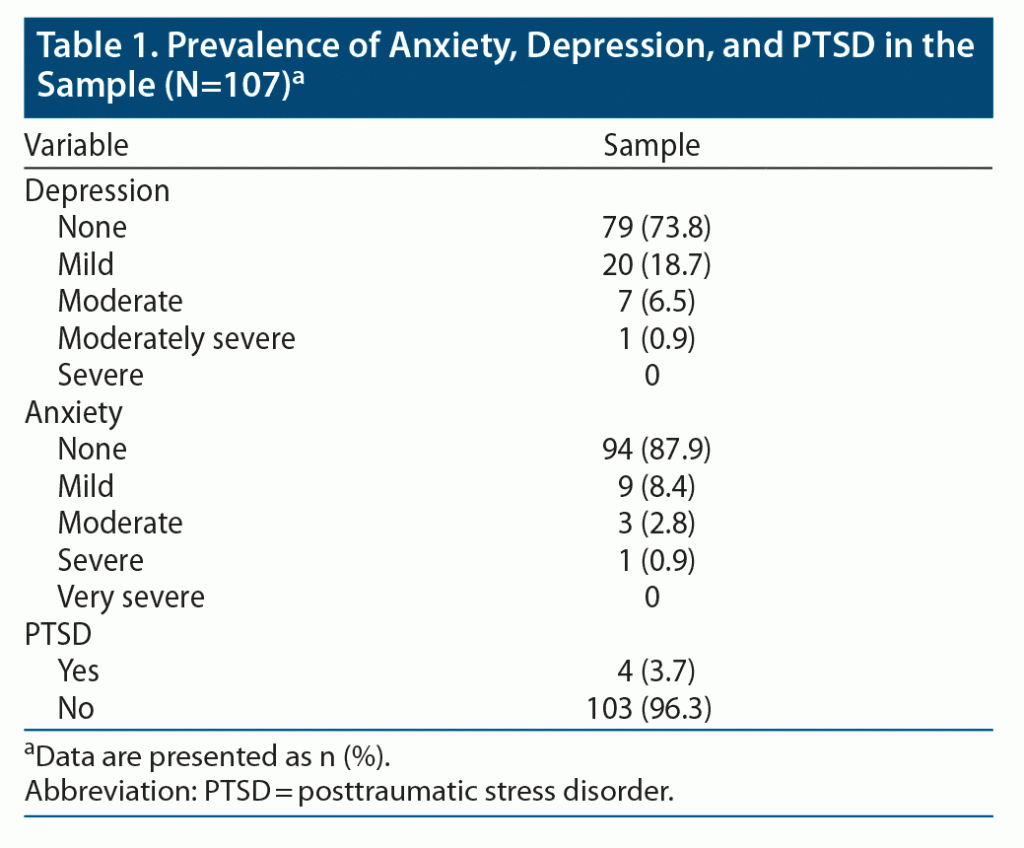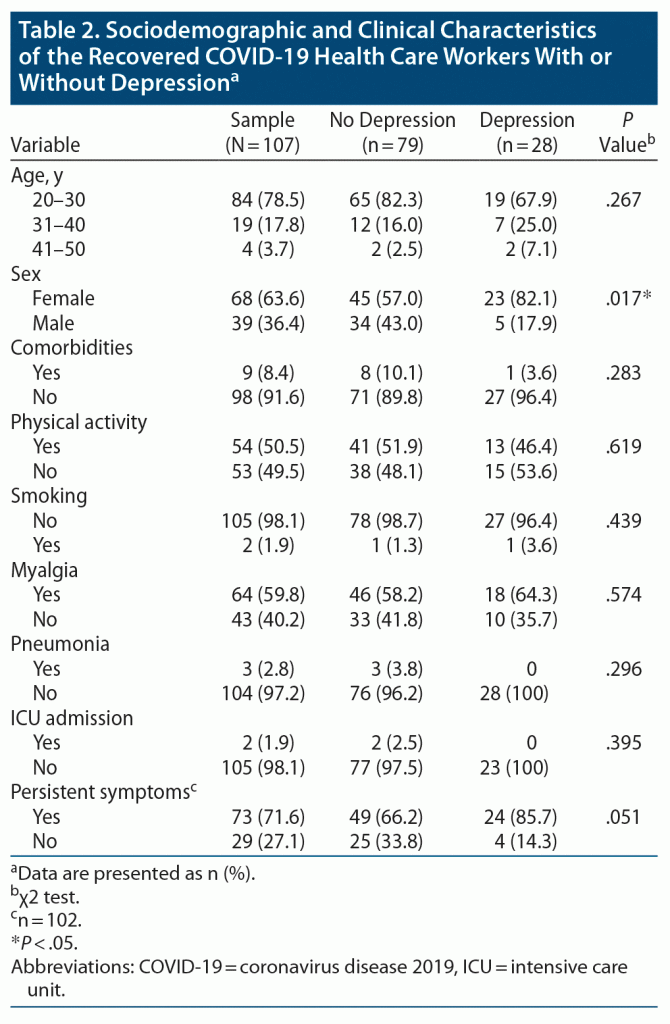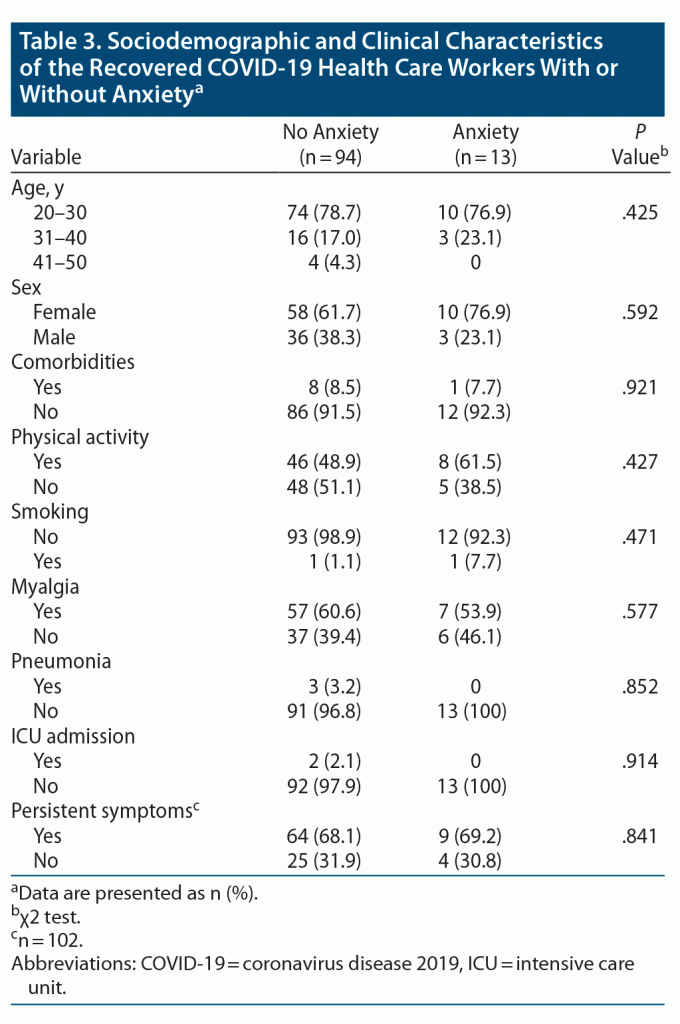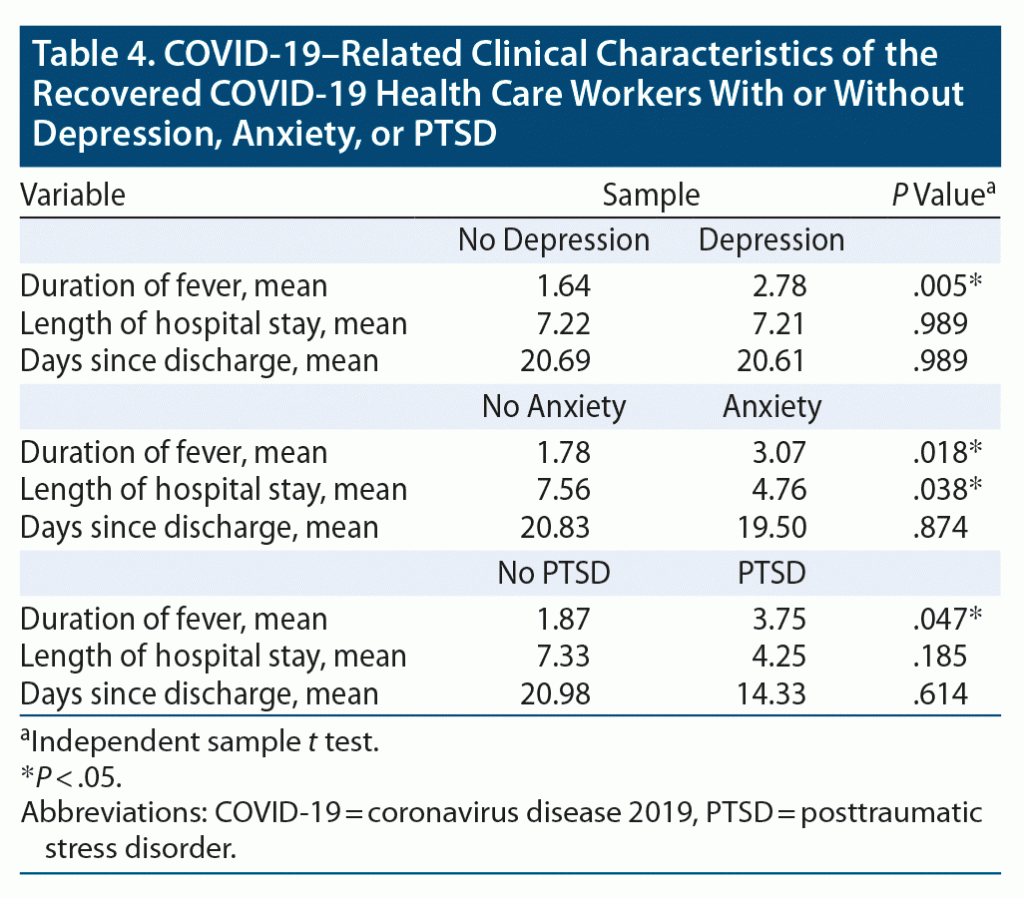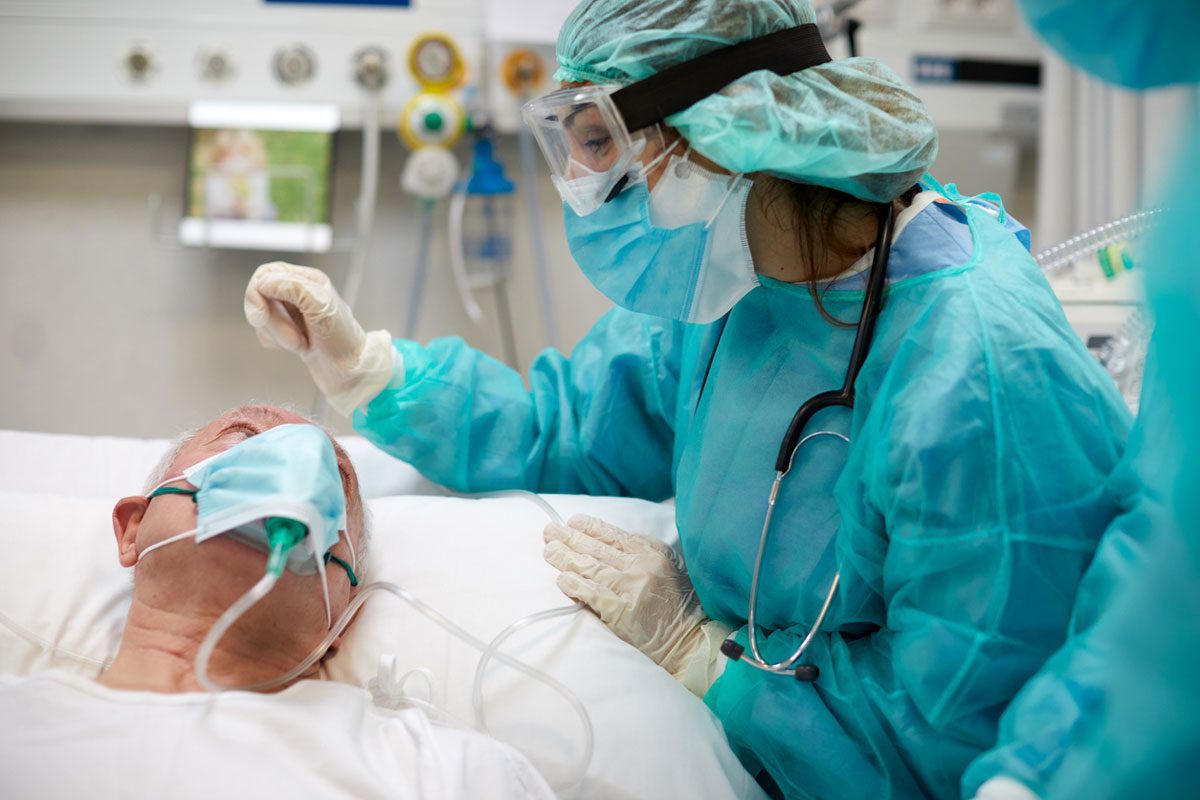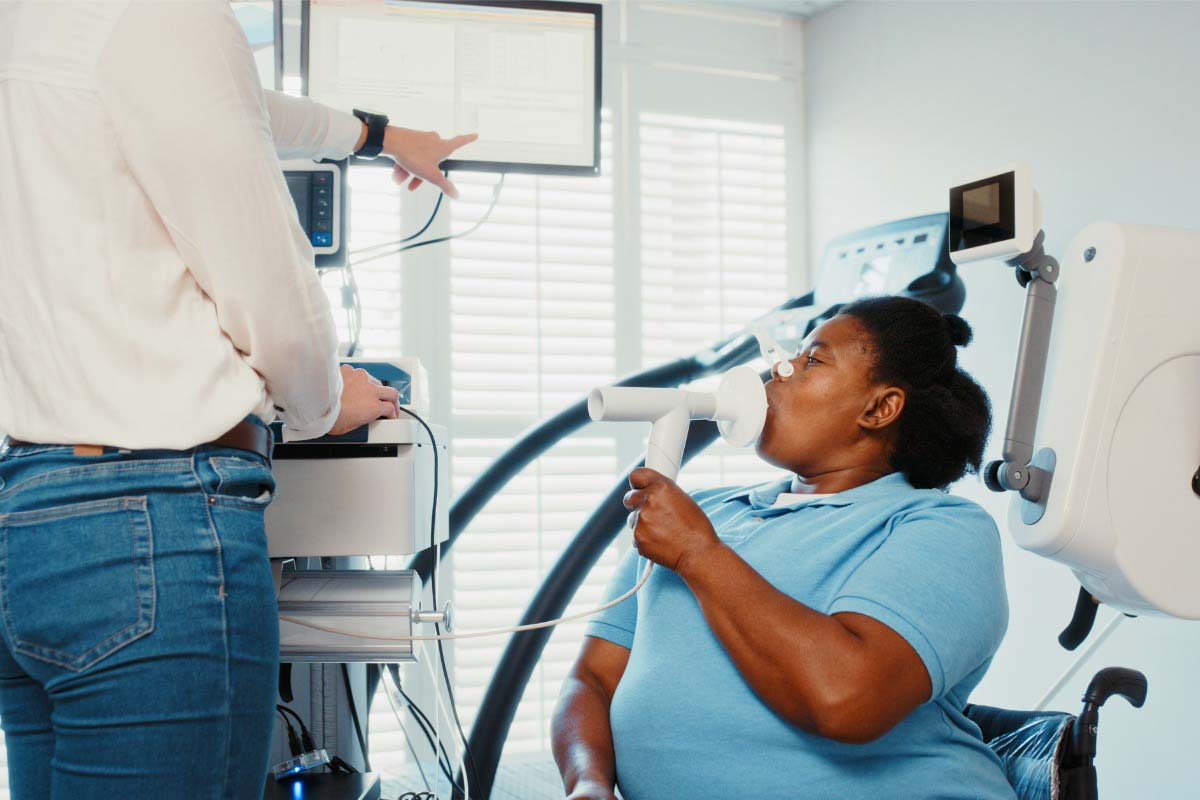ABSTRACT
Objective: A range of psychiatric morbidities such as persistent depression, anxiety, insomnia, and posttraumatic stress disorder (PTSD) has been observed in coronavirus disease 2019 (COVID-19) survivors. The objective of this study was to explore the psychological status of health care workers after recovery from COVID-19 and to examine the sociodemographic and clinical factors associated with psychiatric morbidity.
Methods: A cross-sectional study was conducted among health care workers of a tertiary care hospital in South India. The study included health care workers who tested positive for COVID-19 according to the provisional guidelines of the World Health Organization. The data were collected after they tested negative for COVID-19 from September 2020 to October 2020. The study used a semistructured proforma and rating scales such as the 9-item Patient Health Questionnaire, 7-item Generalized Anxiety Disorder Scale, and Posttraumatic Stress Disorder Checklist for DSM-5 to assess for depression, anxiety, and PTSD.
Results: The results indicate that the prevalence of depression, anxiety, and PTSD among 107 post-COVID patients was 26.2%%, 12.1%, and 3.7%%, respectively. Female sex (P = .017), patients with post-COVID persistent physical symptoms (P = .05), and the duration of fever during the acute phase of COVID-19 infection (P = .005) were found to have a statistically significant association with a higher rate of depression among the study population.
Conclusions: The study findings indicate that all COVID-19 survivors working in the health care sector should be screened for depression and anxiety disorders regularly for early detection and effective management.
Prim Care Companion CNS Disord 2022;24(3):21m03177
To cite: Uvais NA, Moideen S, Rajagopal S, et al. Psychological morbidity among COVID-19 survivors: a cross-sectional study among health care workers. Prim Care Companion CNS Disord. 2022;24(3):21m03177.
To share: https://doi.org/10.4088/PCC.21m03177
© Copyright 2022 Physicians Postgraduate Press, Inc.
aDepartment of Psychiatry, Iqraa International Hospital and Research Centre, Calicut, Kerala, India
bDepartment of Internal Medicine, Iqraa international Hospital and Research Centre, Calicut, Kerala, India
cDepartment of Physical Medicine and Rehabilitation, Iqraa International Hospital and Research Centre, Calicut, Kerala, India
dDepartment of Pharmacy Practice, Teerthenker Mahaveer College of Pharmacy, Moradabad, Uttarpradesh, India
eNandha College of Pharmacy, Erode, Tamil Nadu, India
*Corresponding author: N. A. Uvais, MBBS, DPM, Iqraa International Hospital and Research Centre, Malaparamba, Calicut, Kerala 673009, India ([email protected]).
The impact of novel coronavirus disease (COVID-19) has been devastating worldwide. The pandemic has led to significant loss of life and presents an unprecedented challenge to public health, especially in developing countries. The impact of COVID-19 was significantly worse in India during the second wave. At the time of this writing, 33,816,980 people have been infected with COVID-19 and 448,888 have died (as of October 3, 2021).1
The COVID-19 pandemic significantly changed the normal course of human life across the globe. Apart from strict infection control measures implemented by governments, negative socioeconomic and health consequences also led to negative mental health outcomes in the form of anxiety, depression, and insomnia among various sections of the population worldwide.2–4 The mental health impact of the COVID-19 pandemic was significantly higher among health care workers compared to the general population.5 Studies have documented the significant increase in mental health morbidities among health care workers compared to pre-pandemic levels.6,7 Among health care workers, those working on the frontline reported significantly higher psychiatric morbidities.7 Health care workers in India endured unprecedented work pressure during the second wave of COVID-19, and many became infected with COVID-19 during their self-less service in the high-risk hospital environments with limited resources. As of July 1, 2021, 800 doctors had died in India due to COVID-19 during the second wave alone.8
Accumulating evidence on the psychological morbidities among patients with COVID-19 infection suggests that patients with COVID-19 infection suffer from significant mental health morbidities during the active phase of the illness.9–11 There are multiple potential reasons for the psychiatric morbidities among patients with COVID-19 including the neurotropic nature of the virus, the stress associated with symptoms of the illness, absence of effective medicines, risk of complications and mortality, and the need for self-isolation.11 However, there are only a few studies exploring psychological problems experienced by COVID-19 patients after recovery.12–14 A recent study12 found that 9.92% of COVID-19 patients suffer from depression and 26.45% from insomnia after recovery. Another study13 from Iran exploring the post-discharge mental health status of COVID-19 survivors found that 43.1% and 12.8% patients suffered from anxiety and depression, respectively. Considering the higher prevalence of depression and anxiety among COVID-19 patients during the acute phase of illness, they can potentially develop into chronic psychiatric morbidities after recovery. There are no studies, to the best of our knowledge, exploring psychiatric morbidities among COVID-19 survivors from India to date. In this cross-sectional study, we explored the prevalence of depression, anxiety, and posttraumatic stress disorder (PTSD) and its correlation among health care workers recovered from COVID-19 infection in South India.
METHODS
Participants
This cross-sectional study was conducted among health care workers of a tertiary care hospital in South India. The study included health care workers who tested positive for COVID-19 according to the provisional guidelines of the World Health Organization. The data were collected after they tested negative for COVID-19 from September 2020 to October 2020. The study protocol was approved by the ethics committee of Iqraa International Hospital and Research Centre (IEC/2021/06/04). All the participants provided informed consent before responding to the study questionnaire.
Study Design and Measurements
A structured self-report questionnaire was created for this study. The questionnaire included 5 sections: sociodemographic details, COVID-19 infection–related clinical details, the 9-item Patient Health Questionnaire (PHQ-9),15 the 7-item Generalized Anxiety Disorder Scale (GAD-7),16 and the Posttraumatic Stress Disorder Checklist for DSM-5 (PCL-5).17 The sociodemographic variables included age, sex, smoking status, status of physical activity, and presence of comorbid illnesses. The COVID-19 infection–related clinical details included the following questions: duration of fever, length of hospital stay, days since discharge, history of myalgia, COVID-19 pneumonia, intensive care unit (ICU) admission, oxygen therapy, noninvasive ventilation, mechanical ventilation, and presence of persistent symptoms after recovery from COVID-19.
Depressive episode was measured using the PHQ-9, which assesses 9 depressive symptoms according to the DSM-IV: depressed mood, anhedonia, sleep disturbances, fatigue or lethargy, changes in appetite or body weight, feelings of guilt or worthlessness, difficulty in concentration, feelings of being slow or restless, and suicidal thoughts. Total scores range between 0 and 27. For the PHQ-9, scores of 5 to 9, 10 to 14, 15 to 19, and 20 to 27 corresponded to mild, moderate, moderately severe, and severe depression symptoms, respectively.15
Anxiety disorders were measured with the GAD-7. Total scores range from 0 to 21, with higher scores reflecting higher severity levels of anxiety. Cutoff points of 5, 10, and 15 are interpreted as representing mild, moderate, and severe levels of anxiety, respectively, on the GAD-7.16
Symptoms of PTSD were assessed using the PCL-5, one of the most used tools to screen for PTSD and a valid and reliable measure. This questionnaire contains a 5-point Likert (0 = not at all to 4 = extremely) scale assessing the 20 DSM-5 symptoms of PTSD, with a total sum score (range, 0–80, with 80 denoting maximal symptom severity in the past month). Prevalence was reported using total scores with a cutoff of 30.17
Statistical Analysis
The collected data were entered in Excel format, and the database was established using SPSS 23.0 statistical software for analysis (IBM, Armonk, New York). Continuous variables were expressed as mean ± SD. Categorical variables were expressed as frequencies and percentages. Chi-square was used to compare categorical variables. An independent sample t test was used to test for differences in continuous variables. Pearson correlation was conducted to analyze correlation between continuous variables. Differences were considered statistically significant if P < .05
RESULTS
We received responses from 107 hospital staff who tested positive for COVID-19. Most of the study participants (78.5%) were between the ages of 20 and 30 years, and 68 (63.6%) were female. Also, 8.4% had premorbid medical illnesses before testing positive for COVID-19, 50.5% were engaged in regular physical activities, and 1.9% were active smokers.
Of the study participants, 59.8% had myalgic symptoms associated with COVID-19. Three participants were diagnosed with COVID-19 pneumonia, and 2 required ICU admission. Oxygen therapy, noninvasive ventilation, and mechanical ventilation were required for only a single participant. Persistent symptoms after recovery were reported by 71.6% of the participants. Twenty-eight (26.2%) participants reported clinically significant depression, 13 (12.1%) reported clinically significant anxiety, and only 4 (3.7%) reported clinically significant PTSD symptoms. The prevalence of anxiety, depression, and PTSD is summarized in Table 1.
A total of 28 people (26.2%) were diagnosed with clinically significant depression based on a PHQ-9 score > 5. Twenty (18.7%) participants had mild depression, 7 (6.5%) had moderate depression, and 1 (0.9%) had moderately severe depression. The results of the intergroup comparison using χ2 test showed that there was a statistically significant higher prevalence of depression among females and participants with persistent symptoms. There was no significant difference in the prevalence of insomnia among patients for age, comorbid illness, smoking status, physical exercise, history of myalgia, pneumonia, and ICU admission. The mean duration of fever was found to be significantly higher among participants with depression (2.78 vs 1.64, P = .005). There was no statistically significant association between depression and length of hospital stay and days since discharge from the hospital. Comparison of demographic and clinical characteristics between the depression and nondepression groups among the enrolled COVID-19 survivors is summarized in Table 2.
A total of 23 participants (12.1%) were diagnosed with clinically significant anxiety based on a GAD-7 score > 5. Nine (8.4%) participants had mild anxiety, 3 (2.8%) had moderate anxiety, and 1 (0.9%) had severe anxiety. The results of the intergroup comparison using χ2 test showed that there was no significant difference in the prevalence of anxiety among patients with respect to any sociodemographic or clinical variable. The mean duration of fever was found to be significantly higher among participants with anxiety (3.07 vs 1.78, P = .018). However, the mean length of hospital stay was significantly lower among participants with anxiety (4.76 vs 7.56, P = .038). There was no statistically significant association between anxiety and days since discharge from the hospital. Comparison of demographic and clinical characteristics between the anxiety and nonanxiety groups among the COVID-19 survivors is summarized in Table 3. COVID-19–related clinical characteristics of the recovered COVID-19 health care workers with or without depression, anxiety, and PTSD are summarized in Table 4.
There was a statistically significant association between presence of clinically significant PTSD symptoms and the mean duration of fever (3.75 vs 1.87, P = .047). There was a statistically significant positive correlation between PHQ-9 and GAD-7 scores (0.737, P < .001), PHQ-9 and PCL-5 scores (0.654, P < .001), and GAD-7 and PCL-5 scores (0.591, P < .001).
DISCUSSION
Previous publications during the severe acute respiratory syndrome outbreak reported that survivors may develop more persistent psychological disorders with time after recovering from infectious diseases. However, only a few studies have investigated psychological issues in COVID-19 survivors.13,18,19 Here, we report the prevalence of depression, anxiety, and PTSD in health care workers who previously had COVID-19. The current study, to the best of our knowledge, is the first from India to present data on the short-term psychiatric consequences of COVID-19 infection among health care workers.
The prevalence of depression, anxiety, and PTSD among the 107 COVID-19 survivors is 26.2%, 12.1%, and 3.7%, respectively. The prevalence of depression reported in this study was in line with many other studies from across the world. A similar study from India exploring psychiatric symptoms among COVID-19 survivors conducted at a post-COVID follow-up clinic found that the prevalence of depression and anxiety among post-COVID patients was 21.9% and 11.9%, respectively.18 Another study from Wuhan, China, among COVID-19 survivors showed that 14.2% had depression and 12.2% had anxiety.19 Another study13 from Iran reported that 43.1% and 12.8% post-COVID patients suffered from anxiety and depression, respectively. The prevalence of depression and anxiety in this study is significantly higher compared to the rate of depression and anxiety among active admitted COVID-19 patients from the same geographic area. A recent study11 exploring depression and anxiety among admitted COVID-19 patients found that 9.7% had clinically significant depression and 5.8% had clinically significant anxiety. The rate of depression in this study is also significantly higher compared to the prevalence of depression among the health care staff working in similar hospital settings. A face-to-face study20 conducted among the hospital staff of the hospital in which this study was conducted during the early phase of the COVID-19 pandemic found that 16.4% reported clinically significant depression and 13.8% reported clinically significant anxiety. From the present findings it can be concluded that the psychological morbidities among health care staff previously infected with COVID-19 were significantly higher compared to active COVID-19 patients and noninfected hospital staff. Our study findings indicate that all COVID survivors, especially those working in the health care sector who are already at higher risk for psychological morbidities compared to the general population, should be screened for depression and anxiety disorders regularly so that effective and timely interventions can be planned and implemented.21 Moreover, this study also found that the duration of fever during the acute phase of COVID-19 infection was significantly associated with depression. Apart from severity of the infection in causing psychological distress and depression, immunologic factors also might play a common role, as accumulating scientific evidence suggests a significant role of the immune system in the pathophysiology of depression.22
The prevalence of PTSD in this study23 was significantly lower compared to previous studies. A recent cross-sectional study among 381 White patients in Rome, Italy found that 30.2% of the patients reported PTSD within 30 to 120 days after acute COVID-19 infection. However, another study24 from Italy exploring PTSD among hospitalized COVID survivors at 3-month follow-up found that only 10.4% of the sample received a PCL-5–based diagnosis of PTSD. Another study25 from Egypt found that 72% of COVID survivors experienced moderate-to-severe posttraumatic stress symptoms. Another study26 exploring PTSD among COVID patients using the PCL-5 found that the prevalence of PTSD among the study population was only 6.5%, which is similar to our study. The lower prevalence of PTSD in this study can be explained based on the following points. The mean duration of follow-up after recovery from COVID-19 was small (around 1 month) in this study. A recent study27 showed that the PCL-5 score in COVID survivors was positively correlated with the duration after discharge. Other predictors of PTSD among COVID survivors such as previous psychiatric diagnosis, hospitalization, and stay in an ICU are relatively absent in this study population.
Among the sociodemographic and clinical variables examined, female sex, patients with post-COVID persistent physical symptoms, and the duration of fever during the acute phase of COVID-19 infection were significantly associated with depression among health care workers who had previously had COVID-19. Similar findings were also reported in previous studies. A similar study from India also found that female sex, ongoing stressors, and post-COVID persistent physical symptoms were significantly associated with depression among COVID-19 survivors. The higher prevalence of psychological morbidities among female COVID-19 survivors in the present study was a well-established finding in previous publications.13,18,19
Our study has the following limitations. The study was conducted among health care workers from a single tertiary care hospital in South India. Hence, the findings may not be generalizable to health care workers in general. Moreover, the cross-sectional design of the study limits causal understanding of psychological morbidities among the study population. Well-conducted prospective studies are needed to understand in detail the factors associated with psychological sequelae of COVID-19 infection.
CONCLUSION
The current study presents data on the psychiatric consequences of COVID-19 infection on health care workers. The study findings showed that health care workers who recovered from COVID-19 suffer from significantly higher rates of depression and anxiety. The duration of fever, female sex, and persisting post–COVID-19 physical symptoms were associated with higher rates of depression and anxiety. The study findings indicate that all COVID survivors should be screened for depression and anxiety disorders regularly for early detection and effective management.
Submitted: October 19, 2021; accepted December 29, 2021.
Published online: May 3, 2022.
Relevant financial relationships: None.
Funding/support: None.
References (27)

- Worldometer, October 3, 2021; 11 IST. Worldometer website. Accessed April 2, 2022. https://www.worldometers.info/
- Nochaiwong S, Ruengorn C, Thavorn K, et al. Global prevalence of mental health issues among the general population during the coronavirus disease-2019 pandemic: a systematic review and meta-analysis. Sci Rep. 2021;11(1):10173. PubMed CrossRef
- Salari N, Hosseinian-Far A, Jalali R, et al. Prevalence of stress, anxiety, depression among the general population during the COVID-19 pandemic: a systematic review and meta-analysis. Global Health. 2020;16(1):57. PubMed CrossRef
- Chakraborty K, Chatterjee M. Psychological impact of COVID-19 pandemic on general population in West Bengal: a cross-sectional study. Indian J Psychiatry. 2020;62(3):266–272. PubMed CrossRef
- Krishnamoorthy Y, Nagarajan R, Saya GK, et al. Prevalence of psychological morbidities among general population, healthcare workers and COVID-19 patients amidst the COVID-19 pandemic: a systematic review and meta-analysis. Psychiatry Res. 2020;293:113382. PubMed CrossRef
- Pappa S, Ntella V, Giannakas T, et al. Prevalence of depression, anxiety, and insomnia among healthcare workers during the COVID-19 pandemic: a systematic review and meta-analysis. Brain Behav Immun. 2020;88:901–907. PubMed CrossRef
- De Kock JH, Latham HA, Leslie SJ, et al. A rapid review of the impact of COVID-19 on the mental health of healthcare workers: implications for supporting psychological well-being. BMC Public Health. 2021;21(1):104. PubMed CrossRef
- The Indian Express. IMA flags 800 doctor deaths in second wave [Internet]. The Indian Express website. Accessed October 3, 2021. https://indianexpress.com/article/india/ima-flags-800-doctor-deaths-in-second-wave-7383639/
- Sahoo S, Mehra A, Dua D, et al. Psychological experience of patients admitted with SARS-CoV-2 infection. Asian J Psychiatr. 2020;54:102355. PubMed CrossRef
- Uvais NA, Moideen S, Hafi NAB, et al. Insomnia among active patients with COVID-19: a cross-sectional study. Chronobiol Med. 2021;3(1):31–34. CrossRef
- Uvais NA, Moideen S, Babu F, et al. Depression and anxiety among patients with active COVID-19 infection: a cross-sectional study. Prim Care Companion CNS Disord. 2021;23(5):20br02996. PubMed CrossRef
- Xu F, Wang X, Yang Y, et al. Depression and insomnia in COVID-19 survivors: a cross-sectional survey from Chinese rehabilitation centers in Anhui province [published online ahead or print February 8, 2021]. Sleep Med. 2021. CrossRef
- Salimi Z, Najafi R, Khalesi A, et al. Evaluating the depression, anxiety, stress, and predictors of psychological morbidity among COVID-19 survivors in Mashhad, Iran. Iran J Psychiatry Behav Sci. 2021;15(2):e108972. CrossRef
- Uvais NA, Moideen S, Hafi B, et al. Insomnia in COVID-19 survivors: a cross-sectional study among healthcare workers. Chronobiology in Medicine. 2021;3(3):102–106. CrossRef
- Kroenke K, Spitzer RL, Williams JB. The PHQ-9: validity of a brief depression severity measure. J Gen Intern Med. 2001;16(9):606–613. PubMed CrossRef
- Spitzer RL, Kroenke K, Williams JB, et al. A brief measure for assessing generalized anxiety disorder: the GAD-7. Arch Intern Med. 2006;166(10):1092–1097. PubMed CrossRef
- Weathers FW, Litz BT, Keane TM, et al. The PTSD Checklist for DSM-5 (PCL-5). National Center for PTSD. 2013. US Department of Veterans Affairs website. Accessed April 2, 2022. www.ptsd.va.gov
- Devi D, Monica V, Santosh R, et al. Psychological morbidity among post-COVID-19 patients: a cross-sectional study from Chennai, South India. Indian Journal of Mental Health and Neurosciences. 2021;4(1):10–17. CrossRef
- Mei Q, Wang F, Bryant A, et al. Mental health problems among COVID-19 survivors in Wuhan, China. World Psychiatry. 2021;20(1):139–140. PubMed CrossRef
- Uvais NA, Nalakath MJ, Jose K. Facing COVID-19: psychological impacts on hospital staff in a tertiary care private hospital in India. Prim Care Companion CNS Disord. 2021;23(2):20m02843. PubMed CrossRef
- Uvais NA, Shihabudheen P, Hafi NAB. Perceived stress and stigma among doctors working in covid-19-designated hospitals in India. Prim Care Companion CNS Disord. 2020;22(4):20br02724. PubMed CrossRef
- Guo X, Jiang K. Is depression the result of immune system abnormalities? Shanghai Jingshen Yixue. 2017;29(3):171–173. PubMed
- Mazza MG, De Lorenzo R, Conte C, et al; COVID-19 BioB Outpatient Clinic Study Group. Anxiety and depression in COVID-19 survivors: role of inflammatory and clinical predictors. Brain Behav Immun. 2020;89:594–600. PubMed CrossRef
- Tarsitani L, Vassalini P, Koukopoulos A, et al. Post-traumatic stress disorder among covid-19 survivors at 3-month follow-up after hospital discharge. J Gen Intern Med. 2021;36(6):1702–1707. PubMed CrossRef
- Abdelghani M, Hassan MS, Alsadik ME, et al. Post-traumatic stress symptoms among an Egyptian sample of post-remission COVID-19 survivors: prevalence and sociodemographic and clinical correlates. Middle East Curr Psychiatry. 2021;28(1):20. CrossRef
- Horn M, Wathelet M, Fovet T, et al. Is COVID-19 associated with posttraumatic stress disorder? J Clin Psychiatry. 2020;82(1):20m13641. PubMed CrossRef
- Tu Y, Zhang Y, Li Y, et al. Post-traumatic stress symptoms in COVID-19 survivors: a self-report and brain imaging follow-up study. Mol Psychiatry. 2021;20:1–6. PubMed CrossRef
Please sign in or purchase this PDF for $40.

